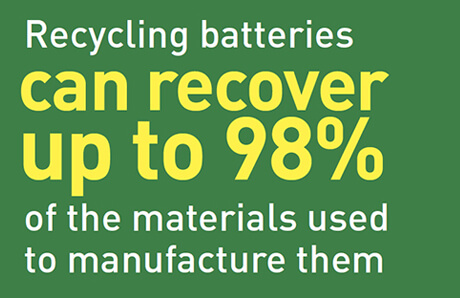Why Recycle Car Batteries?
Batteries provide power for many of the products we use in every day life; from cars and boats to laptops and mobile phones. However, like many manufactured products, batteries can have a negative impact on the environment if not recycled correctly.
Recover & Recycle … or send to landfill?
Materials such as lead, cadmium, mercury, lithium, manganese, nickel and zinc are used to make batteries. These can be recycled an indefinite number of times.
Recycling helps to conserve non-renewable resources, particularly lead.
Lead, cadmium and mercury in particular, are potentially hazardous to our health and the environment. Disposal in landfill means that there is a risk of heavy metals leaking into surrounding groundwater and surface water.
Producing recycled lead from batteries requires 35-40% of the energy needed to produce new lead from ore.
Australians purchase around 6 million automotive batteries each year – of which, approximately 87% are recycled responsibly.

AAA Recycling Centre is one of Adelaide’s leading Used Lead Acid Battery (ULAB) recycling depots. We pay cash for your old car, van and truck batteries.
Today’s automotive batteries are now up to 97% recyclable, the reconstituted materials are used in the manufacture of new battery products.
Don’t dump your old battery and risk a fine, bring it to AAA Recycling Centre, we’ll recycle it correctly, and pay you for doing the right thing!
If you’re in the Burton / Salisbury area of Adelaide’s Northern Suburbs and would like to recycle your battery for cash please call: (08) 8280 6350.
Battery Components

The main components of a car battery are lead (Pb) electrodes and lead dioxide (PbO2) electrodes immersed in a solution of water and sulphuric acid. Typically, these are contained in a polypropylene plastic case.
Sulphuric Acid Recycling
- The battery acid can be treated to produce sodium sulphate, which is used in the manufacture of laundry detergents
- It can also be treated to produce calcium sulphate (gypsum), which is used to produce plasterboard and cement.

Lead Acid Battery Recycling Process
The lead, plastic and electrolyte (sulphuric acid) in used lead acid batteries (ULAB) is recycled. Around 98% of the material in each battery is recycled. The recycling process typically involves:
Breaking the used battery apart in a crushing machine or hammer mill.
The pieces are processed through various tanks, where the different densities of the materials cause some to sink (lead) and some to float (rubber and plastics). The materials are separated and treated individually.
The plastic from the cases is melted using an injection moulding process to produce plastic pellets. These are generally sold to a battery manufacturers to produce new battery cases.
The plastic or fibreglass separators from the polypropylene casing can either be recycled or used as a fuel supplement.

The lead grids and lead oxide are processed in a smelter to produce lead ingots. Some processes combine the waste lead streams, while others feed the paste to a smelter furnace to recover soft lead and feed the grids and terminals to a melting furnace to produce hard lead. The lead is used to produce new batteries.
Did You Know?
Car Batteries can be Recycled into Solar Cells
Researchers from MIT have developed a system which recycles materials from discarded car batteries into long-lasting perovskite solar panels, thus solving several environmental issues.
Recycling car batteries in this way, means manufacturers can divert toxic material from landfills and re-use it in photovoltaic panels. This is particularly important as more efficient types of battery technology, such as lithium-ion batteries, take over.
As the perovskite photovoltaic material takes the form of a thin film just half a micrometre thick, the lead from a single car battery could produce enough solar panels to power 30 households.
Professor Belcher also said that the production of perovskite solar cells ‘has the advantage of being a low-temperature process with fewer steps’ when compared to the conventional process for manufacturing solar cells.


